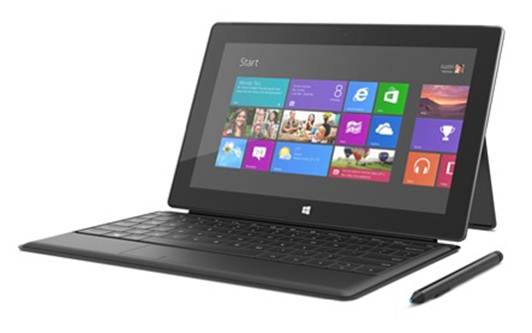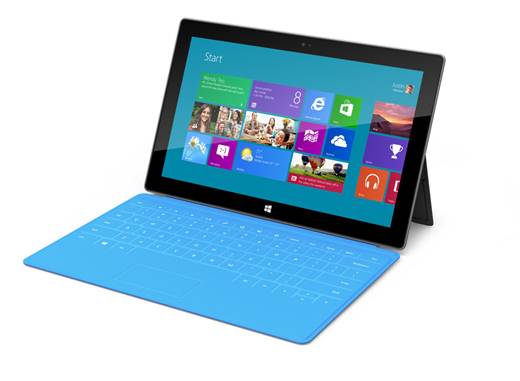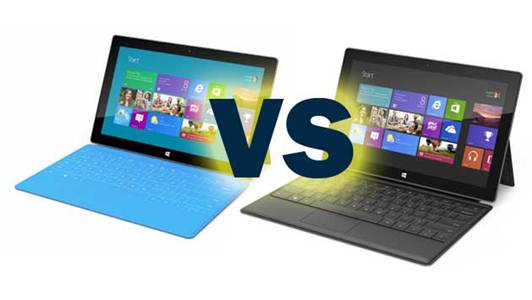Although pricing for the Surface Pro seems high, the
tablet has Ultrabook-level specs and differs significantly from its RT sibling.
THE SURFACE PRO is doomed or so it would seem, given
Microsoft’s prices of $899 (64GB) and $999 (128GB). But if you dig into the
specs, it doesn’t sound like a tablet. With a core i5 CPU, 4GB of RAM, a USB
3.0 port, a memory card slot, and a mini DisplayPort connector, the Surface Pro
(slated for January 2013, though rumors hint it could arrive even before then)
sounds more like an Ultrabook with touch and pen, but without a built in
keyboard.

Surface Pro
How will buyers react to the Pro, considering that
Microsoft’s own Surface RT has been out for a while? No one questions whether
the Surface RT is a tablet. It’s priced like a high-end tablet, it’s thin and
light, and it has competitive battery life. But since that Windows RT tablet
uses Nvidia’s ARM-based Tegra 3 CPU, it can’t run desktop programs.
Buyers may view the Surface Pro as just a pricey tablet as
well. At the prices Microsoft is charging, shoppers who are not paying
attention to its PC like specs will likely ignore it.
Serious PC users who recognize the Surface Pro as a thinly
disguised PC may grab one; they might also buy the Type Cover, or maybe a
Bluetooth keyboard. Corporations may view it with interest too, as Microsoft
has integrated enterprise management capability. They’ll be able to install all
their software on it as well, since it’s a full Windows 8 PC under the hood.
Pro vs. RT
If you’re trying to decide between the Surface Pro and
Surface RT, you should be aware of the benefits and disadvantages of each
Windows platform. Since the Surface Pro isn’t out yet, for the sake of
comparison we looked at several other tablets running Windows 8 Pro.

Surface RT
Battery life: In this respect, Windows 8 Pro tablets
compete with Ultrabooks more than they do other tablets. Our testing of the
Samsung Series 7 Slate, for example, yielded more than 5.5 hours of battery
life and that’s with an Intel Core i5 CPU rather than the more energy-frugal
Atom chips used in many Windows 8 tablets.
Size and weight: Here the two platforms are a mixed
bag, depending on the device model. At 1.9 pounds, the Samsung Series 7 Slate
weighs almost half a pound more than the 1.5-pound surface RT. According to a
blog post by Panos Panay, general manager of Microsoft Surface, the Surface Pro
will weigh less than 2 pounds too.
The Dell Latitude 10, in contrast, is a Windows 8 Pro tablet
listed at 1.47 pounds. The difference is that the Samsung and the Surface Pro
use a traditional PC architecture, while the Atom CPU in the Dell is a SoC
(system on chip) that merges more functionality into less space.
Legacy software: This is where the balance shifts
away from RT tablets. Windows 8 Pro behaves the same on a desktop, laptop, or
tablet, and all of the Windows software you rely on will work on a Windows 8
Pro tablet.
Windows RT can run only apps developed for the Windows RT
Modern interface. The volume and quality of available apps is under-whelming
but growing rapidly. That won’t do you any good, however, if you rely on an
industry-specific application that runs only in the full windows operating
system. The difference, again, is that Windows RT is strictly for ARM-based
processors, while Windows 8 Pro works with x86 processors.
Advanced features: Another area where Windows RT is
no match for Windows 8 Pro is in more-advanced features and capabilities. A Windows
8 Pro tablet, for example, can join a Windows network domain, and be managed
and monitored just like any other Windows computer.
An x86-architecture tablet running Windows 8 Pro or Windows
8 Enterprise can encrypt data via BitLocker. A Windows 8 Enterprise tablet also
opens up another realm of possibilities, including various Microsoft
technologies that are not available for Windows 8 Pro – never mind RT.
Which one wins?
If money is a factor, or if you want a tablet only to
augment your Windows PC, the Surface RT or another Windows RT tablet makes
sense. But if you want to run traditional software, or if you need a more
robust device, a Windows 8 Pro tablet like the Surface Pro will serve you
better.
In the end, what may kill the Surface Pro is its Surface
name. It looks to be an impressive little Windows 8 PC. But if potential buyers
see it as just a high priced tablet, Microsoft could end up with a lot of
excess inventory.

Microsoft Surface
for Windows RT vs Microsoft Surface for Windows 8 Pro
Surface Pro vs Surface RT
Surface Windows RT
·
OS: Windows RT
·
Light: 676 g
·
Thin: 9.3 mm
·
Clear: 10.6" ClearType HD Display
·
Energized: 31.5 W-h
·
Connected: microSD, USB 2.0, Micro HD video, 2x2 MIMO antennae
·
Productive: Office Home & Student 2013 RT, Touch Cove, Type
Cover
·
Practical: VaporMg Case & Stand
·
Configurable: 32GB, 64GB
Surface
Windows 8 Pro
·
OS: Windows 8 Pro
·
Light: 9.3 g
·
Thin: 13.5 mm
·
Clear: 10.6" ClearType HD Display
·
Energized: 42 W-h
·
Connected: microSD, USB 3.0, Mini DisplayPort Video, 2x2 MIMO
antennae
·
Productive: Touch Cove, Type Cover, Pen with Palm Block
·
Practical: VaporMg Case & Stand
·
Configurable: 64GB, 128GB
|